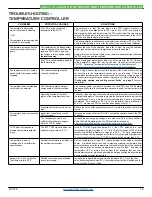
© 2018
19
LDTC2/2 LASER DIODE DRIVER AND TEMPERATURE CONTROLLER
TROUBLESHOOTING –
TEMPERATURE CONTROLLER
PROBLEM
POTENTIAL CAUSES
SOLUTIONS
Temperature is decreasing
when it should be increasing.
–OR–
Temperature is increasing when
it should be decreasing.
The TEC may be connected
backwards to the LDTC.
The convention is that the
red
wire on the TEC module connects to
TEC+ (pin 6) and the
black
wire to TEC- (pin 5). If your TEC is connected in
this manner and the problem persists, the TEC module itself may be wired in
reverse. Switch off power to the system, reverse the connections to the LDTC,
and then try again to operate the system.
TEC wiring polarity is dependent on temperature sensor type (NTC vs. PTC).
Verify that the polarity is correct for the sensor type you are using (
).
Temperature increases beyond
the setpoint and will not come
down.
The heatsink may be inadequately
sized to dissipate the heat from the
load and TEC module, and now
the system is in a condition called
thermal runaway
.
Increase the size of the heatsink, add a fan to blow air over the heatsink,
and/or reduce the ambient air temperature around the heatsink.
Apply a thin layer of thermal paste or use thermal washers between the load,
the TEC surfaces, and the heatsink.
The TEC is not adequately sized for
the thermal load.
The heat being generated by the load may be too great for the TEC to pump
to the heatsink; a larger TEC may be needed. Consult our technical note
TN-TC01: Optimizing Thermoelectric Temperature Control Systems
at
www.teamwavelength.com/download/applicationtechnotes/tn-tc01.pdf
The temperature of my heater-
based system increases without
stopping.
The current limits might not be
correctly configured.
When using a heater the current limit trimpots LIM A and LIM B must be
set according to the temperature sensor type you are using. If the load
temperature increases past the setpoint and continues to increase, one of
the current limit trimpots may have been improperly set. Refer to
and
“Configuring heating and cooling current limits” on page 9
for more
information.
Temperature does not stabilize
very well at the setpoint.
Poor thermal contact between
components of the thermal load.
Use thermal paste or washers between the load/TEC and TEC/heatsink
interfaces. Make sure the temperature sensor is in good thermal contact with
the load.
Operating outside of the ideal
region of the temperature sensor.
The sensor type and bias current should be selected to maximize sensitivity at
the target temperature. Thermistors provide the best performance, particularly
for applications where a single setpoint temperature must be accurately
maintained. For example, at 25°C a 10 kΩ thermistor has a sensitivity of
43 mV/°C, whereas an RTD sensor has a sensitivity of 4 mV/°C.
Proportional control term is set too
high.
Reduce the value of the proportional term. For more information, contact the
factory.
Temperature does not reach the
setpoint.
Insufficient current driven to the
TEC or Heater.
Increase the current limit - but DO NOT exceed the specifications of the TEC
or heater.
The controller does not have
sufficient compliance voltage to
drive the TEC or heater.
Increase the power supply voltage; be certain to verify that the controller is
within the Safe Operating Area; the SOA calculator is found at:
www.teamwavelength.com/support/design-tools/soa-tc-calculator/
LDTC does not respond to
external temperature setpoint
input.
The EXT T SET signal is below the
minimum signal value of 0.3 V.
If the R TC SET signal falls below 0.3 V, the LDTC defaults to a “safe
temperature” setpoint voltage of 1 V (for a 10 kΩ thermistor at 100 µA bias
current, the default temperature setpoint is 25°C). The safe temperature
setpoint voltage can be changed at the factory if your application requires it.
To reset the safety circuit, the R TC SET signal must be greater than 0.4 V.
Temperature is slow to
stabilize and is not within the
specifications.
Setpoint temperature is set close to
the ambient temperature.
Set the temperature at least 10°C above ambient when using a resistive
heater. A resistive heater is unable to precisely maintain temperature near
ambient because once the temperature overshoots the setpoint, the controller
turns off and relies on ambient temperature to cool the load. If setting the
temperature 10°C or more above ambient is not possible, then choose a
thermoelectric cooler, which can alternately heat and cool the load to maintain
a more precise setpoint temperature.
Setpoint is 1 V even when the
Tset trimpot is fully OFF.
Failsafe circuit has been activated
due to low setpoint.
Increase the temperature setpoint to a value above 0.3 V. Once the Tset
value becomes greater than 0.3 V, the failsafe circuit will be disabled and the
setpoint will be at the set value.







































